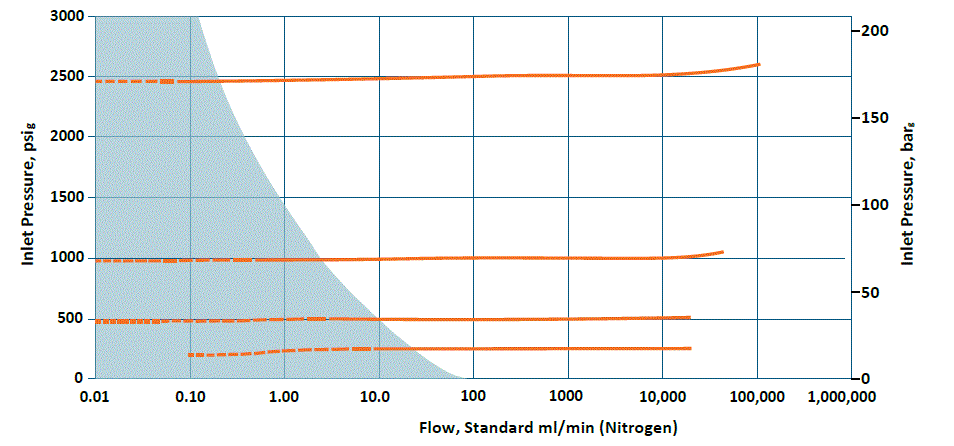The performance curves below demonstrate what is most unique about Equilibar® back pressure regulators (BPRs). The charts show continuous pressure stability across a very wide range of flow rate with both gas (Nitrogen) and liquid (Water) applications.
By using several different diaphragms, the same regulator body can be used to control gas pressures from less than 0.1 psig / .006 bar(g) to above 1000 psig / 68.9 bar(g). Designs are available to control down to extremely low flow rates.
Performance of Equilibar Research Series Back Pressure Regulator with Nitrogen

Equilibar back pressure regulators, with their ultra-sensitive diaphragm-operated multiple orifice technology, maintain precise pressure across a wide range of flow rates with liquids as well. Below is an example of the performance of an FD Sanitary Series regulator controlling water.
Performance of Equilibar 3/4″ Back Pressure Regulator with Water
 Performance curves will vary with port size and diaphragm selection.
Performance curves will vary with port size and diaphragm selection.

See Equilibar precision in action:
- Overview of back pressure regulator technology
- Contact our engineers to discuss which regulator is appropriate for your application.
Precision for Larger Back Pressure Regulators
The precision of larger back pressure regulators is theoretically the same as with smaller research sized units, as described above. However, in practice, larger BPRs are typically sized to achieve a good balance between needed precision and economical body sizing. For example, a 3/4″ BPR might provide a pressure build of 5% at full water flow capacity, whereas a 1″ BPR might have precision in the 2% range. Depending on the accuracy requirements and the user’s budget, your application engineer can help you size a model to meet all your requirements.
Precision at Different Pressure Ranges
Theoretically, it is possible to achieve the same % precision at low pressure setpoints as it is with high pressure setpoints. However, in practice, this is rarely achieved. In order to achieve excellent precision at lower differential pressures, it is necessary to over-size the unit such that the friction from fluid moving through the passages is small relative to the available pressure differential. In ultra-low pressure application, this is rarely achieved due to the economics of supply of very large regulators.


